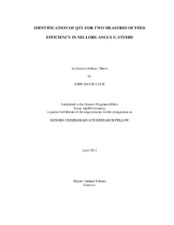| dc.description.abstract | The objective of this study was to map quantitative trait loci for feed efficiency in Bos taurus indicus x Bos taurus taurus crossbred steers. Steers (n = 231) were from 13 full-sibling embryo transfer Nellore-Angus F2 families raised in 9 contemporary groups in central Texas. Steers were fed in a Calan gate system beginning at 11 to 13 mo of age for a 129 to 152 d feeding period. Residual feed intake was calculated within contemporary group. A second measure of feed efficiency termed model predicted residual consumption used the NRC (2000) beef cattle model to predict expected daily dry matter intake. Both residual feed intake and model predicted residual consumption are deviations of observed from expected intake. We also investigated daily dry matter intake, average daily gain, and metabolic body weight, which are components traits for the two measures of efficiency. Residuals from analyses of variance with fixed factors of sire, family nested within sire, and with or without contemporary group as independent variables were used for QTL mapping. Steers were genotyped using the BovSNP50v1assay (Illumina Inc., San Diego, CA) and 34,980 SNP were used for single marker association and interval analyses in PLINK and GridQTL software, respectively. Significance levels were established by permutation. Both single marker association and interval analyses identified suggestive quantitative trait loci (P < 0.05 chromosome-wise) on bovine chromosomes 11 and 21 for model predicted residual consumption and residual feed intake, respectively. There were significant clusters of single nucleotide polymorphisms for daily dry matter intake, average daily gain, and metabolic body weight on bovine chromsome 11 and 14 but not on bovine chromosome 21. Forkhead Box A1 was identified as a candidate gene for the quantitative trait locus on chromosome 21. Breed of origin of a 1 Mb region containing FoxA1 (near 48.6 Mb) accounted for 40% of variation in residual feed intake, 15% of the variation in model predicted residual consumption and 9% of the variation in daily dry matter intake in this crossbred population. | en |


